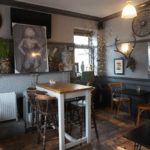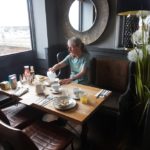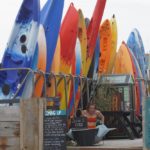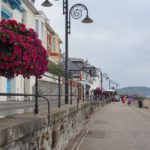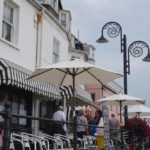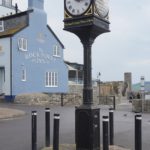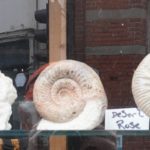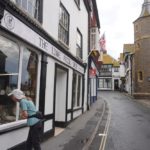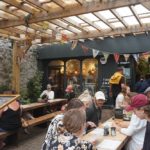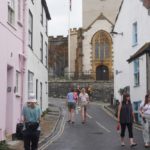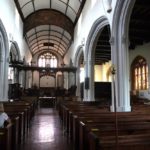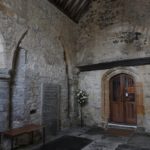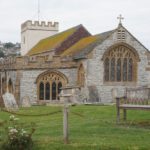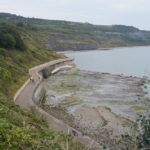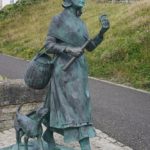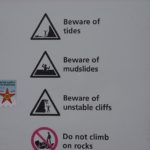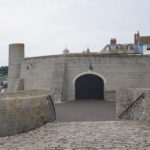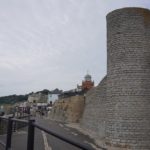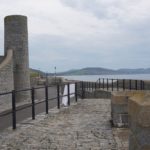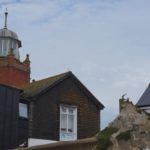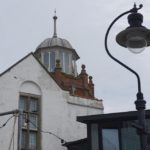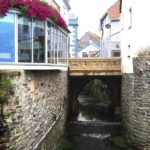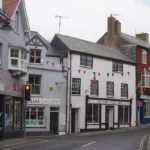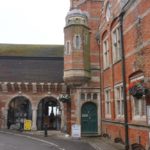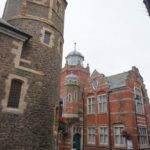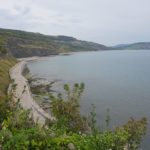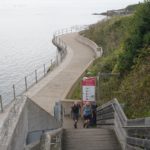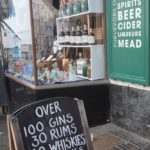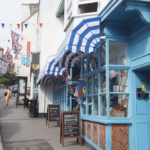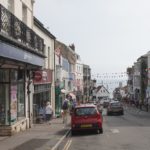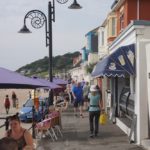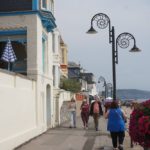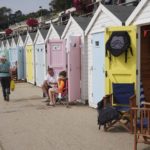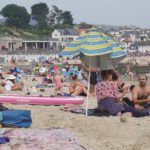Without realising it near the end of yesterday’s walk we crossed from Devon into Dorset. This is the last of the four Counties that make up the South West Coast Path: Somerset, Devon (twice), Cornwall and Dorset. There was absolutely nothing to indicate we had crossed a county line. We will now have to look out for a Dorset Flag
Long ago Lyme Regis was just plain Lyme. In 1284 King Edward I granted the town a royal charter and so the term “Regis” was added – “regis” merely signifying that it has some sort of royal endorsement or connection. There are 19 towns in England with regis added to their name. Lyme Regis is sometimes called The Pearl of Dorset, this is what alerted us to the fact that we were now in Dorset.
It was a bit of a shock entering Lyme Regis yesterday. For four hours we had been walking through the Undercliffs in an English “jungle”. Very still with only the song of the many birds. We met very few people and it was very peaceful. Suddenly you entered a jammed car park with many cars cruising around looking for a spot and you were looking down on The Cobb, the beach and boat harbour of Lyme Regis. A seething mass of humanity. It looked like every inch of sand was occupied and the noise was incredible. The promenade was full of minimally clad over-weight people and there were chip shops, ice cream parlours, fresh fish shops, cafes and bars everywhere. We felt like retreating to the serenity of the Undercliffs. The Cobb is a curved stone sea wall constructed in the thirteenth century to protect the fishing boats in the harbour. The Cobb is famously featured in Jane Austen’s novel Persuasion, and for film buffs in John Fowles book and movie The French Lieutenant’s Woman, starring Jeremy Irons and the fabulous Meryl Streep.
Lyme Regis is nestled on the banks of the River Lim with yesterday’s walk The Undercliffs National Nature Reserve to the west and tomorrow’s walk the fossil- rich Blue Lias cliffs to the east. Today we have a “rest” day in Lyme Regis and boy do we need it.
Those of us of a certain age, ie old, will remember books, films and tv shows about Lassie a collie dog who saved hapless humans from the bottom of wells/cliff faces/disused mine shafts etc, usually by barking at her owner who somehow managed to understand exactly what the problem was and help Lassie to effect a rescue in the nick of time. Local legend has it that the collie was based on a real life rough-haired crossbreed whose owner was the landlord of a Lyme Regis Inn. In WWI a battleship was torpedoed off the South Coast of Devon with the loss of many lives. Eventually a life raft washed up at Lyme Regis and it was thought all those inside were dead. However the curious crossbreed licked one of the supposed cadavers which responded and the occupants of the life raft were revived.
Perhaps the most famous daughter of Lyme Regis is Mary Anning who rose from a poor and uneducated background to become one of the world’s leading and most revered fossil collectors and palaeontologists. She was introduced to fossil hunting by her father who unfortunately died at an early age. She had an extraordinary ability to make significant discoveries and her increasing knowledge on the subject coincided with the 19th century’s fledgling obsession with geology and evolution. Mary collected her fossils along the cliffs that surround Lyme Regis. In 1811 at the age of 12 she unearthed a 17 ft long ichthyosaurus (fish lizard) the skull of which is today in the Natural History Museum in London. Mary’s reputation grew with each new discovery. She discovered a complete plesiosaurus (near lizard) and the first pterodactyl skeleton found outside of Germany. She opened Anning’s Fossil Depot and geologists from around the world visited her and bought her finds. Unfortunately the great social inequality of the time meant that a woman of her background was never going to be given the plaudits she deserved and many of her finds were credited to male palaeontologists who had purchased the items from her. At long last in 2010 she was included in the list of the 10 British women who have most influenced science. She is thought to be the inspiration for the tongue twister: She sells sea shells on the sea shore.
Today was a quiet day, a Sunday so we visited a church, St Michael Archangel the tower of which dates from a thousand years ago. We found Town Mill Bakery, recommended by our good friend David but being Sunday morning it was very busy with a wait to get a table. Besides we had had a late breakfast at the Cobb Arms Hotel. Breakfast at the hotel started at 9.00am and was the slowest breakfast ever. We didn’t escape until 10. We asked it we could get an early breakfast tomorrow as we wanted an early start on what was going to be a long day. The answer was no but they would make us some sandwiches and leave them in the fridge at the bar so we could leave as early as we liked. Very thoughtful.
We also checked out the beginning of the route for tomorrow. The cliffs between Lyme Regis and Charmouth are very unstable and the path has to be regularly re-routed to safe areas. One option is to go along the beach but it must be done on a low ebbing tide as it is impassable at high tide and many people have had to be rescued when stranded on rocks out in the sea. Also you shouldn’t walk close in under the cliffs due to rock falls. The Council has sign posted a route that goes inland along suburban streets but this is long, noisy and tedious. We found the current official Coast Path route which uses the beach promenade then climbs up 114 steps to behind the cliffs with a little street walking near the end to get into Charmouth.
This afternoon we joined the throngs in their thongs and went for a swim at The Cobb Beach. Very nice but not a refreshing as when you have been walking on the coast path. Not as warm today only the low twenties.
- The Cobb Arms Lyme Regis
- The Cobb Arms Lyme Regis
- The Cobb Arms Lyme Regis
- The Cobb Arms Lyme Regis
- Cobb Beach Lyme Regis
- Lyme Regis
- Lyme Regis
- Lyme Regis
- River Lim Lyme Regis
- Fossils Lyme Regis
- Lyme Regis
- Town Mill Bakery Lyme Regis
- Town Mill Bakery Lyme Regis
- St Michael Archangel Lyme Regis
- St Michael Archangel Lyme Regis
- St Michael Archangel Lyme Regis
- St Michael Archangel Lyme Regis
- St Michael Archangel Lyme Regis
- St Michael Archangel Lyme Regis
- Promenade Church Cliffs Lyme Regis
- Mary Anning Lyme Regis
- Lyme Regis East Beach
- Lyme Regis
- Lyme Regis
- Lyme Regis
- Lyme Regis
- Lyme Regis
- River Lim Lyme Regis
- Lyme Regis
- Museum Lyme Regis
- Museum Lyme Regis
- Promenade Church Cliffs Lyme Regis
- Promenade Church Cliffs Lyme Regis
- Lyme Regis (for Bruce)
- Lyme Regis
- Lyme Regis
- Lyme Regis
- Lyme Regis
- The Cobb Beach Lyme Regis
- The Cobb Beach Lyme Regis
- The Cobb Beach Lyme Regis
- The washing after a swim


